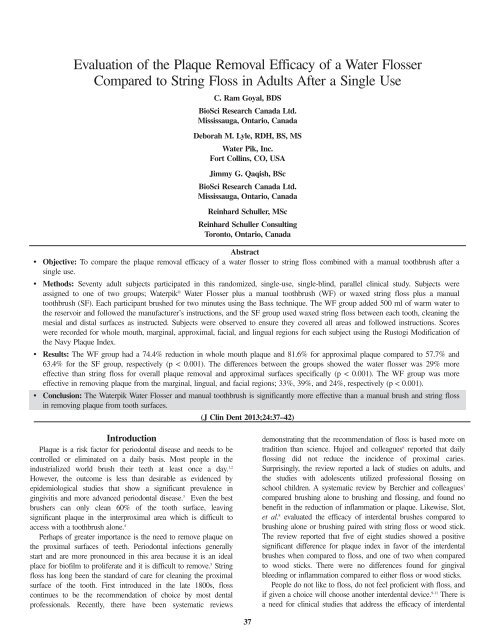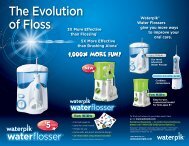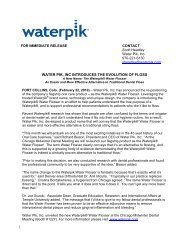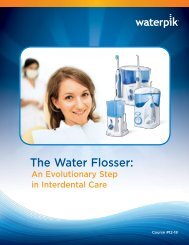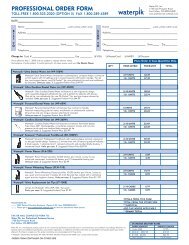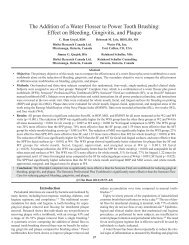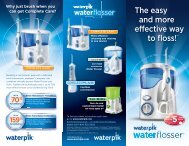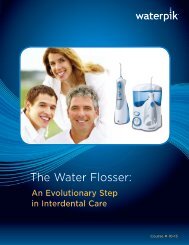Read Full Clinical Study - Waterpik
Read Full Clinical Study - Waterpik
Read Full Clinical Study - Waterpik
- No tags were found...
You also want an ePaper? Increase the reach of your titles
YUMPU automatically turns print PDFs into web optimized ePapers that Google loves.
Evaluation of the Plaque Removal Efficacy of a Water FlosserCompared to String Floss in Adults After a Single UseC. Ram Goyal, BDSBioSci Research Canada Ltd.Mississauga, Ontario, CanadaDeborah M. Lyle, RDH, BS, MSWater Pik, Inc.Fort Collins, CO, USAJimmy G. Qaqish, BScBioSci Research Canada Ltd.Mississauga, Ontario, CanadaReinhard Schuller, MScReinhard Schuller ConsultingToronto, Ontario, CanadaAbstract• Objective: To compare the plaque removal efficacy of a water flosser to string floss combined with a manual toothbrush after asingle use.• Methods: Seventy adult subjects participated in this randomized, single-use, single-blind, parallel clinical study. Subjects wereassigned to one of two groups; <strong>Waterpik</strong> ® Water Flosser plus a manual toothbrush (WF) or waxed string floss plus a manualtoothbrush (SF). Each participant brushed for two minutes using the Bass technique. The WF group added 500 ml of warm water tothe reservoir and followed the manufacturer’s instructions, and the SF group used waxed string floss between each tooth, cleaning themesial and distal surfaces as instructed. Subjects were observed to ensure they covered all areas and followed instructions. Scoreswere recorded for whole mouth, marginal, approximal, facial, and lingual regions for each subject using the Rustogi Modification ofthe Navy Plaque Index.• Results: The WF group had a 74.4% reduction in whole mouth plaque and 81.6% for approximal plaque compared to 57.7% and63.4% for the SF group, respectively (p < 0.001). The differences between the groups showed the water flosser was 29% moreeffective than string floss for overall plaque removal and approximal surfaces specifically (p < 0.001). The WF group was moreeffective in removing plaque from the marginal, lingual, and facial regions; 33%, 39%, and 24%, respectively (p < 0.001).• Conclusion: The <strong>Waterpik</strong> Water Flosser and manual toothbrush is significantly more effective than a manual brush and string flossin removing plaque from tooth surfaces.(J Clin Dent 2013;24:37–42)IntroductionPlaque is a risk factor for periodontal disease and needs to becontrolled or eliminated on a daily basis. Most people in theindustrialized world brush their teeth at least once a day. 1,2However, the outcome is less than desirable as evidenced byepidemiological studies that show a significant prevalence ingingivitis and more advanced periodontal disease. 3 Even the bestbrushers can only clean 60% of the tooth surface, leavingsignificant plaque in the interproximal area which is difficult toaccess with a toothbrush alone. 4Perhaps of greater importance is the need to remove plaque onthe proximal surfaces of teeth. Periodontal infections generallystart and are more pronounced in this area because it is an idealplace for biofilm to proliferate and it is difficult to remove. 5 Stringfloss has long been the standard of care for cleaning the proximalsurface of the tooth. First introduced in the late 1800s, flosscontinues to be the recommendation of choice by most dentalprofessionals. Recently, there have been systematic reviewsdemonstrating that the recommendation of floss is based more ontradition than science. Hujoel and colleagues 6 reported that dailyflossing did not reduce the incidence of proximal caries.Surprisingly, the review reported a lack of studies on adults, andthe studies with adolescents utilized professional flossing onschool children. A systematic review by Berchier and colleagues 7compared brushing alone to brushing and flossing, and found nobenefit in the reduction of inflammation or plaque. Likewise, Slot,et al. 8 evaluated the efficacy of interdental brushes compared tobrushing alone or brushing paired with string floss or wood stick.The review reported that five of eight studies showed a positivesignificant difference for plaque index in favor of the interdentalbrushes when compared to floss, and one of two when comparedto wood sticks. There were no differences found for gingivalbleeding or inflammation compared to either floss or wood sticks.People do not like to floss, do not feel proficient with floss, andif given a choice will choose another interdental device. 9-11 There isa need for clinical studies that address the efficacy of interdental37
38The Journal of <strong>Clinical</strong> DentistryVol. XXIV, No. 2devices. This study compared the plaque removal efficacy of awater flosser to string floss when paired with a manual toothbrushafter a single use.Materials and MethodsSubjectsSeventy-one (71) adult male and female subjects wererecruited for the study (Table I). Subjects were enrolled if theymet the following criteria:1. Able to understand, read, and write in English and providewritten informed consent prior to participation;2. Not enrolled in another clinical study during the day ofexamination;3. Non-smoker in good general health and not pregnant at thetime of the study;4. Reported not using antibiotics within six months of thestudy, require premedication for dental treatment, or have asystemic disease that influences the oral tissue (e.g.,diabetes, autoimmune disease, medication);5. Have a minimum of 20 scoreable teeth (not including 3 rdmolars), no probing depths greater than 5 mm, and aminimum pre-brushing plaque score of 0.6;6. No hard or soft tissue lesions; and7. Good dental health with no visible carious lesions, obviousadvanced periodontal disease, orthodontic appliances, orremovable partial dentures.Figure 1A. Water Flosser (Water Pik, Inc.). The Ultra unit used in the studyincludes five tip designs and pressure setting from low to high (1 – 10).Table IDemographic DataWF Waxed Floss Overall(N = 34) (N = 36) (N = 70)Age (years)Mean 45.2 44.6 44.9SD 10.45 10.27 10.29SEM 1.79 171 1.23Range 25 – 63 25 – 64 25 – 64GenderMale 6 (17.6%) 10 (27.8%) 16 (22.9%)Female 28 (82.4%) 26 (72.2%) 54 (77.1%)SD = Standard Deviation, SEM = Standard Error of the Meanp-value for age (p = 0.962) from a Wilcoxon rank-sum testp-value for gender (p = 0.398) from a Fisher’s Exact testThe study forms and protocol were approved by theinstitutional review board (Institutional BRCL). Subjectscompleted a medical history and read and signed a consent formprior to inclusion in the study.<strong>Study</strong> DevicesThe <strong>Waterpik</strong> ® Ultra Water Flosser (WF group, Model WP-100, Water Pik, Inc., Fort Collins, CO, USA) is a pulsating oralirrigator with a reservoir, pressure control, and handle for tipplacement (Figure 1A). The tip is directed at the gingival marginand approximal areas of all teeth, following a pattern around themouth cleaning the facial and lingual surfaces. The Classic JetFigure 1B. Classic Jet Tip. Tip is held close at a 90-degree angle to the tooth atthe gingival margin and follows a pattern around the mouth to clean all facialand lingual areas of the teeth.Tip was used for this study (Figure 1B), delivering 500 ml ofwarm water using medium-high pressure.Unflavored waxed dental floss (SF group; Johnson &Johnson, Morris Plains, NJ, USA) was precut to 18” andprovided to the subjects. Subjects cleaned the proximal surfacesof all teeth following instructions for wrapping the floss aroundeach tooth on the mesial and distal surfaces forming a “C,” andmoving up and down the surfaces several times.<strong>Study</strong> DesignThis independent, single-blind, single-use, parallel clinicaltrial compared the plaque removal efficacy of a manualtoothbrush paired with either a WF or SF. Subjects wererandomized into one of two groups prior to pre-cleaning plaquescore recording. Group 1 received the WF and group 2 receivedthe waxed string floss (SF). All subjects used a new AmericanDental Association standard manual toothbrush (Oral-B ®Indicator 35, Procter & Gamble, Cincinnati, OH, USA) and
Vol. XXIV, No. 2 The Journal of <strong>Clinical</strong> Dentistry 39Crest ® Cavity Protection Toothpaste, regular mint favor (Procter& Gamble, Cincinnati, OH, USA). The study endpoint was thesingle-use change scores of the Rustogi Modification of theNavy Plaque Index (RMNPI) for whole mouth, marginal,approximal, facial, and lingual areas. 12Subjects abstained from brushing and all other oral hygienemethods for 23–25 hours prior to their appointment. Oral softand hard tissues were assessed at the pre- and post-cleaningevaluations. Subjects rinsed with an erythrosine (FD&C #3)disclosing solution (Gemiphene Corporation, Brantford, ON,Canada) for one minute and then expectorated. Data werecollected by one experienced examiner proficient using theRMNPI, and who was blinded to the treatment assignments.There are nine sections to score with the RMNPI. Sections arecombined to provide data for the marginal and approximalregions (Figure 2).Figure 2. Rustogi Modification of the Navy Plaque Index. Plaque is assessed foreach tooth area (A through I) and is scored using the following scale: 0 =absent, and 1 = present. Facial and lingual surfaces of all gradable teeth arescored and a mean plaque index (MPI) is calculated for each subject at eachexamination. Subjects’ scores were calculated for the whole mouth (areas Athrough I), along the gingival margin (areas A through C), and proximal(approximal; areas D and F).Verbal instructions were given to each subject followed by ademonstration on a mouth model: Bass technique for thetoothbrush; manufacturer’s instructions for the water flosser;and standard flossing instructions for the waxed floss. Eachsubject brushed for a timed two-minutes and was supervised tomake sure they were using the proper technique throughout thebrushing process. They rinsed and immediately commencedwith interdental cleaning using either the WF or SF. The WFgroup filled the reservoir with 500 ml of warm water andplaced the pressure setting on medium-high. The subjects weredone when they had cleaned each interproximal area andproximal surface with the floss or when the WF reservoir wasempty.Statistical AnalysisData were collected for each subject and recorded on CaseReport Forms (CRFs) in black ballpoint pen. The CRFs werecompleted and reviewed for accuracy of all data, and thensigned by the principle investigator. The CRFs underwent keybatch entry and verification. Data were tabulated according tothe clinical scoring appropriate for the RMNPI.With 35 subjects per group, the study would have over 90%power to detect a clinically significant difference when theaverage plaque reduction for the <strong>Waterpik</strong> Water Flosser plusmanual toothbrush is 75% when compared to the averagereduction of 50% for waxed string floss plus manual toothbrushfor whole mouth plaque.The primary outcome was to determine the removal andreduction of plaque from tooth surfaces from pre-treatmentbaseline and between groups measured by the reduction in theRMNPI after a single use.The primary comparison evaluated the mean change betweenthe groups, utilizing a between independent groups one-wayanalysis of variance (ANOVA). Within groups pre-postcomparisons were also evaluated using the pre-post changescore. Data were summarized using descriptive statistics (mean,median, minimum, maximum, and standard deviation) bytreatment group and overall. No statistical adjustments weremade for multiple comparisons or multiple tests. All statisticaltests were conducted using a significance level of α = 0.05.ResultsSeventy subjects (70) completed the study. There were 34subjects in the WF group and 36 subjects in SF group. Onesubject dropped out from the WF group due to personal reasons.There were no differences in demographics or baselinecharacteristics between the groups at baseline. The twotreatments did not differ at pre-treatment for whole mouth andfacial plaque scores and were the same for approximal andmarginal regions, indicating no differences at baseline betweenthe groups. The pre-treatment lingual scores were 0.64 for WFand 0.62 for SF which did differ statistically (p = 0.04), but wasnot considered clinically relevant (Table II).Whole MouthThe WF and SF groups showed statistically significantchanges from pre-cleaning to post-cleaning score for wholemouth RMNPI; 74.4% and 57.7%, respectively (p < 0.001). TheWF group was 29% more effective than the SF group for wholemouth plaque removal (p < 0.001; Table II, Figure 3).Marginal RegionBoth groups showed significant reduction between pre- andpost-cleaning scores; 68.2% for WF group and 51.1% for SFgroup (p < 0.001). The difference between the groups was 33%(p < 0.001), demonstrating a significant difference in favor ofthe WF group (Table II, Figure 3).Approximal RegionThe WF and SF groups showed statistically significant
40The Journal of <strong>Clinical</strong> DentistryVol. XXIV, No. 2Table IIPre-cleaning RMNPI and Post-cleaning Plaque RemovalPre-Cleaning Post-Cleaning Change Score % Change*Mean (SD) Mean (SD) Mean (SD)Whole Mouth WF 0.65 (0.047) 0.17 (0.050) 0.48 (0.043) 74.4%SF 0.64 (0.039) 0.27 (0.069) 0.37 (0.053) 57.7%Marginal WF 1.00 (0.000) 0.32 (0.083) 0.68 (0.083) 68.2%SF 1.00 (0.000) 0.49 (0.114) 0.51 (0.114) 51.1%Approximal WF 1.00 (0.000) 0.18 (0.079) 0.82 (0.079) 81.6%SF 1.00 (0.000) 0.37 (0.101) 0.63 (0.101) 63.4%Facial WF 0.65 (0.069) 0.09 (0.062) 0.56 (0.070) 85.7%SF 0.66 (0.074) 0.20 (0.086) 0.46 (0.070) 69.4%Lingual WF 0.64 (0.041) 0.24 (0.078) 0.40 (0.060) 62.9%SF 0.62 (0.032) 0.34 (0.095) 0.28 (0.076) 45.2%SD = Standard Deviation*Change from pre-cleaning p < 0.001Figure 3. Mean % reduction in Plaque (RMNPI)*Significant difference in favor of the WF compared to SF (p < 0.001) for all assessmentschanges from pre- and post-cleaning scores for the approximalregion; 81.6% and 63.4%, respectively. The WF group showedsuperior plaque removal compared to the SF group (29%, p
Vol. XXIV, No. 2 The Journal of <strong>Clinical</strong> Dentistry 41cleaned regardless of how many times they brush or for howlong. 13 Brushing time and technique are variables that impactoutcomes, with an average brushing time of 50 seconds andtechniques that do not clean the angles and margins effectively. 13Plaque left on tooth surfaces, especially at the marginal area, canimpact the initiation and proliferation of subgingival bacteria,increasing the risk for gingivitis and periodontal infections. 14,15Twice-daily brushing for two minutes is based on empiricalrather than scientific evidence, since asking people to brushmore frequently or longer can be futile. This needs to becoupled with interdental cleaning once daily to control biofilmformation where infection and gingivitis are likely to occur. 5 Theuse of dental floss as the standard of care is questionable andother devices should be investigated.The purpose of this study was to evaluate the efficacy of awater flosser interdental cleaning device and compare it to stringfloss on plaque removal after a single use. The RMNPI allowedfor evaluation of different areas and surfaces of the tooth, andprovided a clearer picture of the plaque removal efficacy of eachproduct. It is interesting to note that string floss has been aroundfor well over a century, but there is little data available tosupport its standing as a primary interdental cleaner. 7 The waterflosser, originally known as an oral irrigator, was first introducedto the dental profession in 1962. Currently, there are over 50clinical studies on one design (<strong>Waterpik</strong> Water Flosser) that hasa pulsation and pressure combination and has shown significantreductions in inflammation and plaque. The water flosser hasbeen tested on many different cohorts such as implants, 16 fixedorthodontics, 17 individuals living with diabetes, 18 gingivitis, 19-21and those with mild to moderate periodontal disease, 22,23demonstrating significant improvements in oral health in favor ofthe water flosser group compared to traditional or normal oralhygiene regimens, including string floss.In this study, the WF group was more effective in removingplaque from all areas and surfaces compared to the SF group.The 29% better reduction in approximal scores is important,especially since the flossing group was instructed and supervisedin the proper technique of wrapping the floss around the toothso that this area would be cleaned; thereby expecting the bestresults from the subjects in this situation. The WF was alsomore effective on the lingual (39%) and marginal (33%) areascompared to floss. These areas should be cleaned easily with atoothbrush, but as noted, people do not brush effectively. Awater flosser has the added benefit of cleaning these areas alongwith the toothbrush without adding another device or rinse.Additionally, research has shown that the water flosser cleanssignificantly deeper than a manual toothbrush, 24 which mayreach one mm using the Bass technique. 25 The water flosser hasbeen shown to reach on average 50% of the pocket with 75%penetration in the majority of pockets > 7 mm. 24This water flosser study looked at pre and post measures forplaque removal compared to string floss. Longer studies haveshown a reduction in plaque with a water flosser compared tobaseline or floss over time. 17,19 In one study the plaque removalwas equivalent to the floss group, but the improvements ingingival inflammation were significantly more effective for thewater flosser. 21 It has also been reported that improvements inoral health with a water flosser were not related only toimprovements in plaque, but related to a down regulation of proinflammatorymediators. 26 This study was designed to look atplaque removal specifically.All products were found to be safe to use and there were noreported adverse events from the single brushing and interdentalcleaning with either the WF or SF. Subjects did not have anyproblems using either product. These results are in line withother studies that showed a significant reduction in plaque frombaseline in favor of the water flosser compared to the controlgroup. The question of whether a water flosser can removeplaque has been answered in the affirmative. More importantly,the outcomes showing a reduction in inflammation, 19-23,26 pocketdepth, 26 subgingival bacteria, 27-29 and gingival bleeding 19-23 instudies of four weeks and greater can support the regularrecommendation of the water flosser as a key device inmaintaining optimal oral health.ConclusionsFrom an analysis of this clinical trial we observed the following:1. The <strong>Waterpik</strong> Water Flosser paired with a manualtoothbrush is significantly more effective than string floss forremoving plaque. Specifically, the group utilizing the WFhad 29%–39% better plaque removal.2. The WF is significantly more effective than string floss inreducing plaque, including in hard-to-reach areas of themouth often missed by brushing.3. Both the WF and SF are safe to use.Acknowledgment: The authors would like to thank the team at BioSciResearch Canada, Ltd. for their valuable contribution to this study. This studywas supported by a research grant from Water Pik, Inc., Fort Collins, Colorado.For correspondence with the authors of this paper, contactDeborah M. Lyle – dlyle@waterpik.com.References1. Saxer UP, Yankell SL. Impact of improved toothbrushes on dental diseases.I. Quintessence Int 1997;28:513-25.2. Saxer UP, Yankell SL. Impact of improved toothbrushes on dental diseases.II. Quintessence Int 1997;28:573-93.3. Sheiham A, Netuveli GS. Periodontal diseases in Europe. Periodontol 20002002;29:104-21.4. De la Rosa MR, Guerra JZ, Johnson DA, Radike AW. Plaque growth andremoval with daily brushing. J Periodontol 1979;50:661-4.5. Papapanou PN. World workshop in clinical periodontics. Periodontaldiseases: epidemiology. Ann Periodontol 1996;1:1-36.6. Hujoel PP, Cunha-Cruz J, Banting DW, Loesche WJ. Dental flossing andinterproximal caries: a systematic review. J Dent Res 2006;85:298-305.7. Berchier CE, Slot DE, Haps S, van der Weijden GA. The efficacy ofdental floss in addition to a toothbrush on plaque and parameters of gingivalinflammation: a systematic review. Int J Dent Hyg 2008;6:265-79.8. Slot DE, Dorfer CD, van der Weijden GA. The efficacy of interdentalbrushes on plaque and parameters of periodontal inflammation: asystematic review. Int J Dent Hyg 2008;6:253-64.9. Lang WP, Ronis DL, Farghaly MM. Preventive behaviors as correlates ofperiodontal health status. J Public Health Dent 1995;55:10-7.10. Tedesco LA, Keffer MA, Fleck-Kandath C. Self-efficacy, reasoned action,and oral health behavior reports: a social cognitive approach to compliance.J Behav Med 1991;14:341-55.
42The Journal of <strong>Clinical</strong> DentistryVol. XXIV, No. 211. Kleber CJ, Putt MS. Formation of flossing habit using a floss-holdingdevice. J Dent Hyg 1990;64:140-3.12. Rustogi KN, Curtis JP, Volpe AR, Kemp JH, McCool JJ, Korn LR.Refinement of the Modified Navy Plaque Index to increase plaque scoringefficiency in gumline and interproximal tooth areas. J Clin Dent1992;3(Suppl C):C9-12.13. Claydon NC. Current concepts in toothbrushing and interdental cleaning.Periodontol 2000 2008;48:10-22.14. Ximénez-Fyvie LA, Haffajee AD, Som S, Thompson M, Torresyap G,Socransky SS. The effect of repeated professional supragingival plaqueremoval on the composition of the supra- and subgingival microbiota. JClin Periodontol 2000;27:637-47.15. Axelsson P. Mechanical plaque control. In: Proceedings of the 1 st EuropeanWorkshop on Periodontology, Lang NP, Karring T, eds. QuintessencePublishing Co. Ltd., London, pp.219-43, 1993.16. Felo A, Shibly O, Ciancio SG, Lauciello FR, Ho A. Effects of subgingivalchlorhexidine irrigation on peri-implant maintenance. Am J Dent 1997;10:107-10.17. Sharma NC, Lyle DM, Qaqish JG, Galustians J, Schuller R. Effect of adental water jet with orthodontic tip on plaque and bleeding in adolescentpatients with fixed orthodontic appliances. Am J Orthod Dentofacial Orthop2008;133:565-71.18. Al-Mubarak S, Ciancio S, Aljada A, Awa H, Hamouda W, Ghanim H,Zambon J, Boardman TJ, Mohanty P, Ross C, Dandona P. Comparativeevaluation of adjunctive oral irrigation in diabetics. J Clin Periodontol2002;29:295-300.19. Barnes CM, Russell CM, Reinhardt RA, Payne JB, Lyle DM. Comparisonof irrigation to floss as an adjunct to tooth brushing: effect on bleeding,gingivitis, and supragingival plaque. J Clin Dent 2005;16:71-7.20. Goyal CR, Lyle DM, Qaqish JG, Schuller R. The addition of a waterflosser to power toothbrushing: effect on bleeding, gingivitis, and plaque. JClin Dent 2012;23:57-63.21. Rosema NAM, Hennequin-Hoenderdos NL, Berchier CE, Slot DE, LyleDM, van der Weijden GA. The effect of different interdental cleaningdevices on gingival bleeding. J Int Acad Periodontol 2011;13:2-10.22. Flemmig TF, Epp B, Funkenhauser Z, Newman MG, Kornman KS,Haubitz I, Klaiber B. Adjunctive supragingival irrigation with acetylsalicylicacid in periodontal supportive therapy. J Clin Periodontol 1995;22:427-33.23. Newman MG, Cattabriga M, Etienne D, Flemmig T, Sanz M, KornmanKS, Doherty F, Moore DJ, Ross C. Effectiveness of adjunctive irrigation inearly periodontitis: multi-center evaluation. J Periodontol 1994;65:224-9.24. Eakle WS, Ford C, Boyd RL. Depth of penetration in periodontal pocketswith oral irrigation. J Clin Periodontol 1986;13:39-44.25. Jepsen S. The role of manual toothbrushes in effective plaque control. In:Proceedings of the European Workshop on Mechanical Plaque Control, LangNP, Attström R, Löe H, eds. Berlin, Quintessenz Verlag, pp. 121-37, 1998.26. Cutler CW, Stanford TW, Abraham C, Cederberg RA, Boarman TJ, RossC. <strong>Clinical</strong> benefits of oral irrigation for periodontitis are related toreduction of pro-inflammatory cytokine levels and plaque. J ClinPeriodontol 2000;27:134-43.27. Cobb CM, Rodgers RL, Killoy WJ. Ultrastructural examination of humanperiodontal pockets following the use of an oral irrigation device in vivo. JPeriodontol 1988;59:155-63.28. Drisko CL, White CL, Killoy WJ, Mayberry WE. Comparison of darkfieldmicroscopy and a flagella stain for monitoring the effect of a WaterPik ® on bacterial motility. J Periodontol 1987;58:381-6.29. Chaves ES, Kornman KS, Manwell MA, Jones AA, Newbold DA, WoodRC. Mechanism of irrigation effects on gingivitis. J Periodontol1994;65:1016-21.


